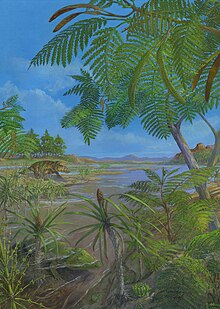Bulgosuchus[1] is an extinct genus of prehistoric amphibians, known from an incomplete mandible and a femur recovered from the Bulgo Sandstone at Long Reef in Sydney, Australia. The type species is Bulgosuchus gargantua, which was named in 1999.[2][1]
| Bulgosuchus Temporal range: Early Triassic,
| |
|---|---|

| |
| Holotype mandible of B. gargantua | |
| Scientific classification | |
| Domain: | Eukaryota |
| Kingdom: | Animalia |
| Phylum: | Chordata |
| Order: | †Temnospondyli |
| Suborder: | †Stereospondyli |
| Clade: | †Capitosauria |
| Family: | †Mastodonsauridae |
| Genus: | †Bulgosuchus Damiani, 1999 |
| Species: | †B. gargantua
|
| Binomial name | |
| †Bulgosuchus gargantua Damiani, 1999
| |

The type specimen is AM F80190, the posterior glenoid section of a left mandibular ramus, and the mandible is estimated to have been at least one metre long.[1][2][3]
At the time of discovery, Bulgosuchus was described as the largest known temnospondyl from the Early Triassic.[4][5]
See also
editReferences
edit- ^ a b c "Bulgosuchus gargantua Damiani, 1999". Museums Victoria. Retrieved 11 June 2018.
- ^ a b Damiani, Ross J. (1999). "Giant temnospondyl amphibians from the Early to Middle Triassic Narrabeen Group of the Sydney Basin, New South Wales, Australia". Alcheringa. 23 (2): 87–109. doi:10.1080/03115519908619324.
- ^ Kear, Benjamin P.; Hamilton-Bruce, Robert J. (2011). Dinosaurs in Australia: Mesozoic Life from the Southern Continent. CSIRO Publishing. p. 48. ISBN 9780643102316.
- ^ DAMIANI, ROSS J. (2001). "A systematic revision and phylogenetic analysis of Triassic mastodonsauroids (Temnospondyli: Stereospondyli)". Zoological Journal of the Linnean Society. 133 (4): 379–482. doi:10.1111/j.1096-3642.2001.tb00635.x. ISSN 0024-4082.
- ^ Poropat, Stephen F.; Bell, Phil R.; Hart, Lachlan J.; Salisbury, Steven W.; Kear, Benjamin P. (2023-04-03). "An annotated checklist of Australian Mesozoic tetrapods". Alcheringa: An Australasian Journal of Palaeontology. 47 (2): 129–205. doi:10.1080/03115518.2023.2228367. ISSN 0311-5518.